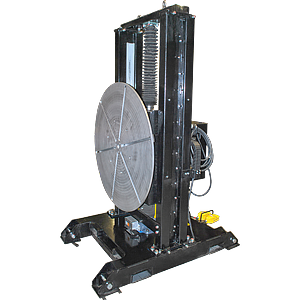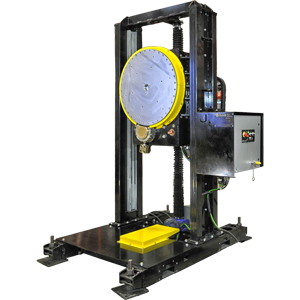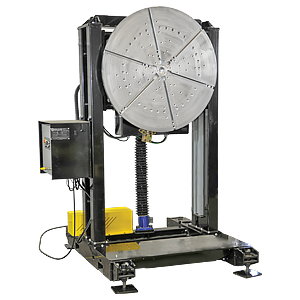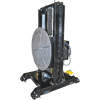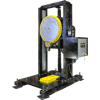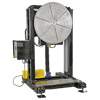POWERED HEADSTOCK & TAILSTOCK WELDING POSITIONERS
- Synchronized Powered Headstock & Tailstock Welding Positioners allow for maximum flexibility when lifting or rotating heavy workpieces such as trailer frames or large vessels. All heavy duty welding positioners come with optional tailstocks.
| Decrease Human Error: Our Powered Headstock & Tailstock Positioners are digitally synchronized to eliminate human error associated with fit resulting in improved labour safety | |
| Custom Height Range: Height ranges on our Powered Headstock & Tailstock Positioners can be modified to customers' unique positioning requirements, reducing manual positioning to the minimum | |
| Increased Productivity: LJ’s Powered Headstock & Tailstock Positioners allow for maximum flexibility when lifting or rotating heavy workpieces essentially increasing weld productivity, and speeding up fabrication | |
| Remote Control: The headstock tailstocks can be controlled remotely by hand pendant, foot switch or locally providing a lot flexibility |
WHAT ARE POWERED HEADSTOCK POSITIONERS?
Our powered headstock positioners represent a reliable and robust solution for the most demanding welding operations, making welding of larger, heavier pipes that require precision welding in upside-down positions easier and safer.
The powered headstock positioner can be adjusted up or down with simultaneous power elevation, further providing maximum flexibility when working in confined spaces. From trailer frames to large vessels, our powered headstock positioners provide maximum flexibility for lifted or rotated workpieces.
Designed with user friendly controls and safety in mind...
At LJ Welding, we know that safety is paramount when it comes to welding operations. That’s why we’ve designed our positioners with synchronized, user friendly controls to virtually eliminate human error and improve labor safety.
Like all our positioners, the powered headstock positioners come equipped with emergency stop buttons and fault detection systems so that welds are executed with complete safety and accuracy every time while reducing potential repair costs due to faulty welds or mistakes being made during operation.
We also offer custom heights for positioning requirements which results in reducing manual work to the minimum, and remote control features that give you even more flexibility in your operations.
Interested in our Powered Headstock Positioners? Contact Us Today!
POWERED HEADSTOCK & TAILSTOCK POSITIONER SELECTION
FREQUENTLY ASKED QUESTIONS ABOUT POWERED HEADSTOCK POSITIONERS
How do the tailstock positioners work?
The tailstock mechanism in powered headstock positioners enables the movement of a workpiece in two axes, typically up and down (vertical axis) and side-to-side or side to back (horizontal axis). The tailstock usually consists of a base with an adjustable slide which moves along two linear ways, it can be clamped to a table or other surface for stability, and it supports the cylindrical barrel in which the cutting tool is placed.
As the spindle on the headstock turns, it drives an internal gear which rotates an external drive wheel on the tailstock. This motion imparts force to push or pull on a movable carriage mounted inside the barrel, allowing fine control over its position as well as its angular orientation relative to the table surface. Tailstocks are most commonly used in woodworking and metalworking operations such as milling processes.
What are the factors to consider when selecting a powered headstock positioner?
When selecting a powered headstock positioner, several factors must be taken into consideration. First and foremost, it is important to determine the maximum weight capacity required for the head and tailstock configuration. The load should be evenly distributed between the two units, with neither supporting more than half of the load, as determined by the center of gravity location along the rotational centerline. If either unit is overloaded, an increased capacity model may be necessary.
Another important factor to consider is the rotation torque load of the weldment. This can be calculated by multiplying the weight of the weldment by the distance in inches that the center of gravity will be from the center of the table. It is important not to exceed the maximum load torque.
Overhung loads must also be taken into account when selecting a head and tailstock. The weight and distance of the center of gravity from the table surface must be determined, along with a suitable positioner.
What is the key advantage of using a powered headstock positioner over a gear-driven positioner?
The primary advantage of using a powered headstock-tailstock positioner over a gear-driven positioner is that it requires much less floor space. With a gear-driven positioner, the workpiece would need to be mounted crosswise on the table, which could result in an extended workpiece that would require a significant amount of space.
Additionally, if the workpiece was secured only at one end, the extended center of gravity and load moment would require an enormous positioner base, assuming the workpiece did not deform under its own weight. Using a powered headstock-tailstock positioner eliminates this issue by allowing the workpiece to be supported at both ends, making it a more efficient use of space.
Are the powered headstock positioners suitable for welding in corrosive environments?
Yes, the powered elevation headstock-tailstock positioners are suitable for welding in corrosive environments as all parts are coated with anti-corrosive materials.
Side-By-Side Powered Headstock & Tailstock Positioner Comparison
|
Specifications |
|||
| Load Capacity | 6,000 lbs (at 12” overhung load) | 12,000 lbs (at 12” overhung load) | 24,000 lbs (at 12” overhung load) |
| Footprint | 67-¼” x 53-⅞” x 91-9/16” | 89” x 76” x 118-⅜” | 96-½” x 89-⅞” x 121-¼” |
| Turning Torque | 60,000 in-lbs | 125,000 in-lbs | 250,000 in-lbs |
| Turning Speed | 0.1 - 2.5 RPM | 0.05 - 2.2 RPM (Other speed options available) | 0.05 – 1.2 RPM (Other speed options available) |
| Height Range | 24” - 72” (at mounting plate) | 42" – 96" (at mounting plate) | 42”–96” (at mounting plate) |
| Lifting Speed | 3 - 30 ipm | 3 - 27 ipm | 2 - 18 ipm |
| Mounting Plate Diameter | 42” (T-Slot Plate with 6 x 5/8" slots) | 52” (T-Slot Plate with 6 x 3/4" slots) | 60” (T-Slot Plate with 6 x 1" slots) |
| Power Requirements | 480V, 5A, 3-ph, 60Hz | 480V, 13A, 3-ph, 60Hz | 480V, 13A, 3-ph, 60Hz |
| Ground Capacity | 800 Amps | 1,500 Amps | 1,500 Amps |
| Weight | 2,970 lbs | 6,390 lbs | 9,600 lbs |



